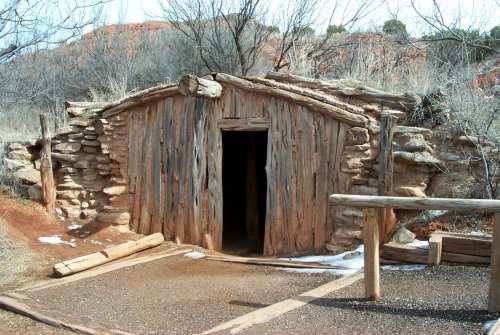Charles Goodnight
Texas Cowman and Plainsman

Goodnight's restored dugout in Palo Duro Canyon


Goodnight's restored dugout in Palo Duro Canyon

Charles Goodnight, born in 1836 in Macoupin County, Illinois, entered the cattle business on the northwest Texas frontier at the age of 20. He also served with the local militia in their long-running battle against Comanche raiders. Goodnight joined the Texas Rangers in 1857 and fought for the Confederacy in the Civil War. He took pride in the fact that he was born at the same time as the Republic of Texas and that he "joined" Texas the year it joined the Union.
At the war's end, Goodnight joined in "making the gather" -- a near state-wide round-up of cattle that had roamed free during the four long years of war. Having recovered his herd, however, Goodnight now faced the problem of bringing it to market somewhere outside the war-ravaged South. He decided to head west, toward New Mexico and Colorado, despite the fact that getting there would mean driving the herd across a waterless stretch of west Texas.
Goodnight's partner in this venture was an older rancher named Oliver Loving (1812-1867). In1866 they set out with two thousand head to blaze a trail from Belknap, Texas, to Fort Sumner, New Mexico, which became known as the Goodnight-Loving Trail. Once in New Mexico, Loving headed north to Colorado, while Goodnight headed back to Texas for another herd. Between them they had made more than $12,000. Loving died after fighting off a band of Comanches who attacked him on the trail to New Mexico in 1867. Goodnight also participated in the battle that "rescued" Cynthia Ann Parker from the Comanches. Later, he would form a lasting friendship with her Comanche son, Quanah. Over the following years the Goodnight-Loving Trail became one of the most heavily traveled in the Southwest.
In 1876, within the bounds of the present Palo Duro Canyon State Scenic Park, Goodnight constructed his first temporary living quarters, a dugout topped with cottonwood and cedar logs, with abandoned Comanche lodge poles as rafters. Subsequently, farther to the southeast in Armstrong County, where the canyon floor widened out for ten miles or more, Goodnight built a comfortable three-room ranchhouse from native timber without using any nails. He also built corrals and a picket smokehouse at the site, which he affectionately dubbed the Home Ranch.
In 1877, Goodnight and John G. Adair, a financier from Denver, formed a partnership that launched the JA Ranch. During his eleven years with the JA, Goodnight devoted his time and energy to expanding the range, building up the herd, and establishing law and order in the Panhandle. In the summer of 1878 he took the first JA trail herd, led by his famous lead steer Old Blue, north to Dodge City, Kansas, then the nearest railhead. The Palo Duro-Dodge City Trail, which he blazed, was well-used in subsequent years by many Panhandle ranchers. Late that fall, when destitute Indians from the reservations came to hunt the now-scarce buffalo, Goodnight made his famous treaty with Quanah Parker in which he promised two beeves every other day for Parker's followers provided they did not disturb the JA herd.
By the time of Adair's death in 1885, the JA had reached its maximum of 1,325,000 acres, on which grazed more than 100,000 head of Goodnight's carefully bred cattle. In addition, Goodnight was a pioneer in the use of artificial watering facilities and the ownership of permanent ranges in fee. As an early believer in improvement through breeding, he developed one of the nation's finest herds through the introduction of Hereford bulls, and became the first Panhandle rancher to build fences of barbed wire
Near the town that bears his name he built his spacious, two-story ranchhouse, into which he and his wife moved on December 27, 1887. As civic leaders and promoters of the higher education he was denied, Goodnight and his wife opened Goodnight College at Goodnight in 1898. The Goodnight Ranch became a major Panhandle tourist attraction and featured buffalo meat on its menus. Buffalo from the Goodnight herd were shipped to zoos in New York and other eastern cities, Yellowstone National Park, and even to Europe, and Goodnight's wildlife-preservation efforts gained the attention of noted naturalists. Goodnight died at his winter home in 1929 in Phoenix at the age of ninety-three.
Charles Goodnight's papers are housed in the Research Center of the Panhandle-Plains Historical Museum in Canyon, Texas. A larger-than-life sized statue of Charles Goodnight (shown above) is on the grounds of the museum.
Lonesome Dove, a novel by Larry McMurtry,
was loosely based on true accounts involving Charles Goodnight and Oliver Loving
Send comments, suggestions or inquiries:
Overland Trail
Created and maintained by Elizabeth Larson
Copyright © 1996-2001